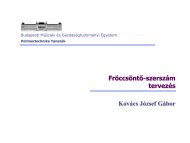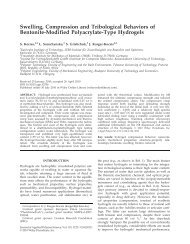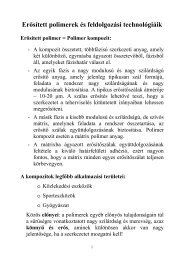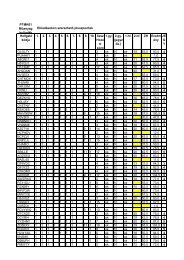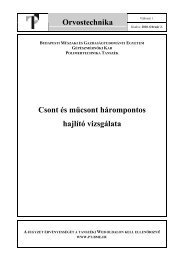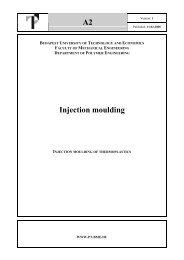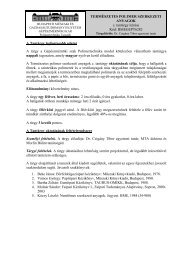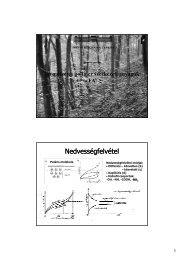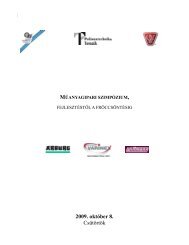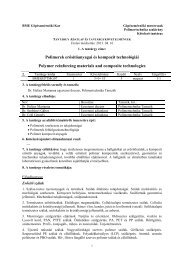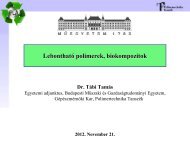Synergetic effect of carbon nanofibers and short carbon fibers on the ...
Synergetic effect of carbon nanofibers and short carbon fibers on the ...
Synergetic effect of carbon nanofibers and short carbon fibers on the ...
You also want an ePaper? Increase the reach of your titles
YUMPU automatically turns print PDFs into web optimized ePapers that Google loves.
CARBON 48 (2010) 4289– 4300 4297<br />
Load (mm)<br />
K IC<br />
(MPa m 1/2 )<br />
G IC<br />
(KJ/m 2 )<br />
120<br />
100<br />
80<br />
60<br />
40<br />
20<br />
a<br />
EP<br />
0.5NF<br />
10CF<br />
10CF0.5NF<br />
0<br />
0.0 0.1 0.2 0.3 0.4 0.5 0.6 0.7<br />
2.0<br />
1.6<br />
1.2<br />
0.8<br />
0.4<br />
0.0<br />
0.7<br />
0.6<br />
0.5<br />
0.4<br />
0.3<br />
0.2<br />
0.1<br />
0.0<br />
b<br />
EP<br />
EP<br />
EP<br />
c<br />
EP<br />
EP<br />
EP<br />
CNF/EP<br />
0.125NF<br />
0.25NF<br />
0.125NF<br />
0.25NF<br />
CNF/EP<br />
0.5NF<br />
0.75NF<br />
0.5NF<br />
Displacement (mm)<br />
CNF/<br />
nano-SiO 2<br />
/<br />
EP<br />
0.25NF1Si<br />
0.75NF<br />
0.25NF1Si<br />
0.25NF3Si<br />
SCF/EP<br />
10CF<br />
5CF<br />
10CF<br />
15CF<br />
Materials<br />
CNF/<br />
nano-SiO 2<br />
/<br />
EP<br />
0.25NF3Si<br />
10CF<br />
5CF<br />
Materials<br />
SCF/EP<br />
10CF<br />
15CF<br />
10CF0.125NF<br />
SCF/CNF/EP<br />
10CF0.25NF<br />
SCF/CNF/EP<br />
10CF0.125NF<br />
10CF0.25NF<br />
10CF0.5NF<br />
10CF0.5NF<br />
10CF0.75NF<br />
Fig. 7 – CT load–displacement curves <str<strong>on</strong>g>of</str<strong>on</strong>g> typical materials<br />
studied (a); fracture toughness, K IC , (b) <str<strong>on</strong>g>and</str<strong>on</strong>g> critical energy<br />
release rate, G IC , (c) <str<strong>on</strong>g>of</str<strong>on</strong>g> all materials studied. Dash lines in (b)<br />
<str<strong>on</strong>g>and</str<strong>on</strong>g> (c) indicating <strong>the</strong> levels <str<strong>on</strong>g>of</str<strong>on</strong>g> two reference materials, i.e.<br />
pure EP <str<strong>on</strong>g>and</str<strong>on</strong>g> EP + 10 vol.% SCFs, are added for easier<br />
comparis<strong>on</strong>s.<br />
10CF0.75NF<br />
The crack in SCF-filled composites produces a typical zigzag<br />
pattern, as was intensively analyzed by Karger-Kocsis<br />
<str<strong>on</strong>g>and</str<strong>on</strong>g> Friedrich [7–9]. Fig. 8c shows that <strong>the</strong> EP matrix fails in<br />
a brittle manner in <strong>the</strong> SCF/EP composite (10CF). With respect<br />
to <strong>the</strong> SCF/CNF/EP composite (i.e. 10CF0.75NF), <strong>the</strong> fracture<br />
plane <str<strong>on</strong>g>of</str<strong>on</strong>g> <strong>the</strong> matrix is much rougher <str<strong>on</strong>g>and</str<strong>on</strong>g> numerous microcracks<br />
appear, as is seen from Fig. 8d. Fig. 8e <str<strong>on</strong>g>and</str<strong>on</strong>g> f dem<strong>on</strong>strates<br />
<strong>the</strong> fracture surfaces <str<strong>on</strong>g>of</str<strong>on</strong>g> <strong>the</strong> SCF/CNF/EP composites<br />
at high magnificati<strong>on</strong>s. Extensive deformati<strong>on</strong> <str<strong>on</strong>g>of</str<strong>on</strong>g> <strong>the</strong> matrix<br />
is observed <strong>on</strong> <strong>the</strong> fracture surface due to <strong>the</strong> presence <str<strong>on</strong>g>of</str<strong>on</strong>g><br />
CNFs. For <strong>the</strong> c<strong>on</strong>venti<strong>on</strong>al composites filled with SCFs, due<br />
to <strong>the</strong> stress c<strong>on</strong>centrati<strong>on</strong> occurring near fiber ends a limited<br />
plastic z<strong>on</strong>e (also termed damage z<strong>on</strong>e) develops near <strong>the</strong><br />
fracture plane as schematized in Fig. 9a. The stress transfer<br />
realized by CNFs, followed by pull-out, breakage <str<strong>on</strong>g>and</str<strong>on</strong>g> deb<strong>on</strong>ding<br />
<str<strong>on</strong>g>of</str<strong>on</strong>g> CNFs, can participate in <strong>the</strong> stress redistributi<strong>on</strong> process<br />
<str<strong>on</strong>g>and</str<strong>on</strong>g> thus can relieve <strong>the</strong> overstress <strong>on</strong> SCF ends. In<br />
additi<strong>on</strong>, CNF-related failures trigger extensive microcracks<br />
<str<strong>on</strong>g>of</str<strong>on</strong>g> matrix in <strong>the</strong> CNF–CNF ligaments <str<strong>on</strong>g>and</str<strong>on</strong>g> <strong>the</strong> CNF–SCF ligaments<br />
as a result <str<strong>on</strong>g>of</str<strong>on</strong>g> shear yielding <str<strong>on</strong>g>of</str<strong>on</strong>g> <strong>the</strong> matrix. As a c<strong>on</strong>sequence,<br />
a larger plastic z<strong>on</strong>e develops because o<strong>the</strong>r SCFs can<br />
now be involved in <strong>the</strong> stress transfer, as schematically illustrated<br />
in Fig. 9b. This is assumed to be <strong>the</strong> major reas<strong>on</strong> for<br />
<strong>the</strong> synergetic roles <str<strong>on</strong>g>of</str<strong>on</strong>g> <strong>the</strong> multiscale <str<strong>on</strong>g>carb<strong>on</strong></str<strong>on</strong>g> fillers. In comparis<strong>on</strong><br />
to spherical nanoparticles (i.e. nano-SiO 2 as reported<br />
in [27]), <strong>the</strong> high aspect ratio CNF is more efficient to enhance<br />
<strong>the</strong> fracture toughness <str<strong>on</strong>g>of</str<strong>on</strong>g> SCF-filled EP. That is, in order to get<br />
comparable fracture toughness, a smaller fracti<strong>on</strong> <str<strong>on</strong>g>of</str<strong>on</strong>g> CNFs<br />
(than spherical nanoparticles) is required to be combined<br />
with SCFs. This can be attributed to <strong>the</strong> high aspect ratio <str<strong>on</strong>g>of</str<strong>on</strong>g><br />
CNFs which allow an efficient stress transfer <str<strong>on</strong>g>and</str<strong>on</strong>g> <strong>the</strong>reby,<br />
an efficient release <str<strong>on</strong>g>of</str<strong>on</strong>g> stress c<strong>on</strong>centrati<strong>on</strong>s occurring near<br />
to <strong>the</strong> SCF ends.<br />
4. C<strong>on</strong>clusi<strong>on</strong>s<br />
The <str<strong>on</strong>g>effect</str<strong>on</strong>g>s <str<strong>on</strong>g>of</str<strong>on</strong>g> CNFs (nanosized), <str<strong>on</strong>g>and</str<strong>on</strong>g> <strong>the</strong> combinati<strong>on</strong> <str<strong>on</strong>g>of</str<strong>on</strong>g> CNFs<br />
<str<strong>on</strong>g>and</str<strong>on</strong>g> SCFs (microsized) <strong>on</strong> <strong>the</strong> tensile <str<strong>on</strong>g>and</str<strong>on</strong>g> fracture properties<br />
<str<strong>on</strong>g>of</str<strong>on</strong>g> EP were studied. The loading <str<strong>on</strong>g>of</str<strong>on</strong>g> CNFs <str<strong>on</strong>g>and</str<strong>on</strong>g> SCFs varied from<br />
0.125 to 0.75 vol.% <str<strong>on</strong>g>and</str<strong>on</strong>g> from 5 to 15 vol.%, respectively. The<br />
tensile properties <str<strong>on</strong>g>and</str<strong>on</strong>g> <strong>the</strong> fracture mechanical properties <str<strong>on</strong>g>of</str<strong>on</strong>g><br />
SCF/EP, CNF/EP, <str<strong>on</strong>g>and</str<strong>on</strong>g> SCF/CNF/EP composites were compared.<br />
It was revealed that <strong>the</strong> SCF/CNF/EP composites exhibit much<br />
higher fracture toughness <str<strong>on</strong>g>and</str<strong>on</strong>g> much better mechanical properties<br />
than <strong>the</strong> composites filled uniquely with CNFs or SCFs.<br />
The multiscale <str<strong>on</strong>g>carb<strong>on</strong></str<strong>on</strong>g> fillers improved <strong>the</strong> tensile <str<strong>on</strong>g>and</str<strong>on</strong>g> fracture<br />
mechanical properties <str<strong>on</strong>g>of</str<strong>on</strong>g> EP synergistically. Based <strong>on</strong><br />
<strong>the</strong> work d<strong>on</strong>e <strong>the</strong> following c<strong>on</strong>clusi<strong>on</strong>s can be drawn:<br />
1. Filled uniquely with CNFs, <strong>the</strong> E-modulus <str<strong>on</strong>g>of</str<strong>on</strong>g> <strong>the</strong> EP was<br />
slightly increased. The tensile strength <str<strong>on</strong>g>and</str<strong>on</strong>g> fracture<br />
toughness were moderately enhanced with <strong>the</strong> additi<strong>on</strong><br />
<str<strong>on</strong>g>of</str<strong>on</strong>g> CNFs. Filled with microsized SCFs, <strong>the</strong> modulus <str<strong>on</strong>g>and</str<strong>on</strong>g><br />
<strong>the</strong> fracture toughness <str<strong>on</strong>g>of</str<strong>on</strong>g> EP are str<strong>on</strong>gly improved. However,<br />
<strong>the</strong> tensile strength decreased with <strong>the</strong> additi<strong>on</strong> <str<strong>on</strong>g>of</str<strong>on</strong>g><br />
SCFs.<br />
2. The combined use <str<strong>on</strong>g>of</str<strong>on</strong>g> CNFs <str<strong>on</strong>g>and</str<strong>on</strong>g> SCFs (multiscale <str<strong>on</strong>g>carb<strong>on</strong></str<strong>on</strong>g><br />
fillers) leads to significant synergetic <str<strong>on</strong>g>effect</str<strong>on</strong>g>s <strong>on</strong> <strong>the</strong><br />
mechanical <str<strong>on</strong>g>and</str<strong>on</strong>g> fracture properties <str<strong>on</strong>g>of</str<strong>on</strong>g> epoxy. The c<strong>on</strong>tributi<strong>on</strong>s<br />
<str<strong>on</strong>g>of</str<strong>on</strong>g> <strong>the</strong> combined fillers to <strong>the</strong> E-modulus, tensile<br />
strength <str<strong>on</strong>g>and</str<strong>on</strong>g> fracture toughness are significantly higher<br />
than <strong>the</strong> superpositi<strong>on</strong> <str<strong>on</strong>g>of</str<strong>on</strong>g> <strong>the</strong> separate c<strong>on</strong>tributi<strong>on</strong>s <str<strong>on</strong>g>of</str<strong>on</strong>g><br />
<strong>the</strong> respective fillers achieved in <strong>the</strong> composites filled<br />
uniquely with SCFs or CNFs. The distinctly different<br />
scales <str<strong>on</strong>g>of</str<strong>on</strong>g> SCFs <str<strong>on</strong>g>and</str<strong>on</strong>g> CNFs are believed to be crucial for <strong>the</strong>




